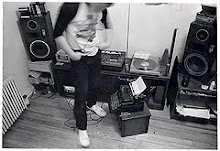In 1983, a young college student plundered his student loan money to buy an analog synthesizer. That young man was me, of course, and the synthesizer was the amazing Sequencial Circuits Pro One. Sadly, it's long gone from my studio. But one creation I squeezed from it left a lasting impression on a generation of innocent youth.
Back the day my dad was in advertising and promotion and one of his firm's clients was Children's Television Workshop, of Sesame Street and Muppets fame. Papa threw me a bone, hired me to create a three second sound track for the CTW video sign-on above. I was paid $50.
Every sound came from the Sequential Circuits Pro One, recorded on a TASCAM 144 4-track cassette recorder, the original Portastudio. The synth had a 16-step programmable sequencer, which I employed at hyper speed for the cascading effect. I layered more sounds on top of that and ran it through an analog delay pedal. Bingo.
I scarcely gave it a thought for years, but recently, when searched YouTube for it on a lark, I found that many people had posted the sign-on, and it was getting views. I did some quick math and found our ancient video logo had received, easily, over half a million hits.
That was delightful to discover, but it was the comments that were really surprising. I was astounded to learn that a more than a few children had been traumatized by the spot. They found my soundtrack and the visuals truly frightening. Just read this sampling of YouTube comments:
"This version of the CTW logo should've been one of the scariest logos in television history."— danucciguzman
"yay i'm not the only one who was freaked out by this!!!"— girlintheflesh78
"omg! i thought i was the only one who this scared, lol."— bluebeary07
"That always scared the hell out of me when I was little."— chrisz71
"Oh...My...Gosh... Scared me SO bad when I was little. I hid under my covers when it would come on!! :O"— LuckyPup551
It scared me too. I wouldn't watch my sesame street tape because of it"— Colleen Perisutti
But there were also these:
"Pretty sweet soundtrack."— OmniInc
"i love this it was my childhood i will never forget it"— daminmancejin










